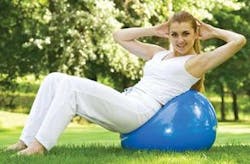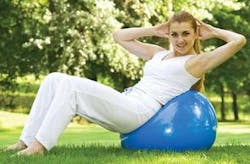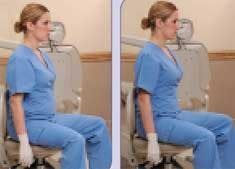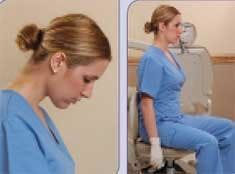Mind Your Body to Work Without Pain
Movement is the key to keeping your body healthy and preventing musculoskeletal disorders.
by Juli Kagan, RDH, MEd
The dental professional is in a postural crisis. On a monthly basis, professional dental journals and general population articles focus on the biomechanical problems that cause aches, pains, disorders, and complaints that make life miserable for people who are seated over long periods for their professions. These conditions can affect the receptionist awkwardly cradling the phone in between the ear and shoulder, the hygienist who is often in the same forced position for long periods of time, or the assistant, hygienist, or dentist who have to lean precariously on movable casters. Add emotional and mental stress and the result is often debilitating.
Unfortunately, knowing better doesn't always translate into doing better. You know you shouldn't cramp your neck or shoulder while positioning yourself for hard–to–reach areas. You know you shouldn't lean or twist to reach over for the saliva ejector, keyboard, or view the monitor. But you do these things anyway. You also know you can stretch and relieve tight muscles, but unfortunately you just don't. Despite the availability of ergonomic chairs and work spaces, and the plethora of information on preventive back care, the fact remains that many of us still suffer aching joints and muscles due to awkward and precarious positions.
How is the dental professional really doing?
The only routinely collected national source of information about occupational injuries and illnesses among U.S. workers is the annual survey conducted by the Bureau of Labor Statistics of the U.S. Department of Labor.1
In 2002 (the last year of available data) the Bureau reported approximately 1,436,000 cases of repetitive motion injuries, which led to recuperative days away from work. Of these, 974,000 affected the neck, back, and shoulder. Over 76,000 of the injuries were due to repetitive motion, including typing or key entry, repetitive use of tools, and repetitive placing, grasping, or moving objects that affected the wrist, shoulder, and again, back.
A substantial body of credible epidemiological research provides strong evidence of an association between musculoskeletal disorders and specific physical exposures, especially when the exposures are intense, prolonged, and workers are exposed to several risk factors simultaneously.
Very controlled, forceful, and awkward positions are often overwhelming due to the repetitive nature of tasks and time spent performing them. Add to that the notion of incomplete recovery, or little rest, and it is no wonder that the dental professional endures work–related musculoskeletal disorders.
Knowing that our bodies are being strained, ergonomics specialists have designed more automated workplaces which strive to take the pressure off our bodies. For example, in the 1960s, dentists were trained to sit rather than stand when practicing, to alleviate lower extremity pain. However, sitting brought a whole new set of problems and merely replaced one injured area with another. The bottom line is that, in general, dental professionals are terribly out of balance.
A Pain in the Neck
Dental professionals are particularly prone to tension in the neck due to dysfunction or over function of the shoulder, neck, and back muscles. Spinal trouble often results as a cascading sequela of these overtaxed muscles. Spinal instability and spinal pain go hand–in–hand.
There are many unfavorable habits that dental professionals must consider regarding back and shoulder pain. First, we routinely shift between awkward positions, especially after sitting for long periods of time. Second, we are required to do repetitive motions throughout the day, and third, we are often under inordinate stress that exacerbates an already compromised musculoskeletal system. Add up any of these and we're bound to show symptoms of dysfunction.
If your lower back or upper shoulders are frequently strained and fatigued, it is almost certain that your posture, muscles, ligaments, joints, tendons, and bones are not balanced. Your alignment and strength will both improve when you decrease the strain on the musculoskeletal system.
Lower back and trunk problems are often due to a disparity between a person's anatomy and physiology. When you are seated, the pressure on soft tissue structures of the lower lumbar spine and discs between the spinal vertebrae is increased. In addition, one must add harmful spinal twisting and rotation, forward and side bending, and a disproportionate weight distribution, which are all done nearly unconsciously throughout the day.
Muscle stiffness and tightening often create a surging pain, which causes further immobility. This motionlessness causes more stiffening, which leads to further tightening and more severe muscular back pain. The cycle is debilitating.
What Are You Waiting For?
It is astounding that so little preventive care and attention is given to dental professionals regarding back care, upper body exercises, or what can be done proactively to prevent postural and bodily harm. Without preventive measures the consequences can be serious. The resulting dysfunctional spine and weak upper body invariably lead to pain, missed work, forced early retirement, and medical interventions — to say nothing of the economic hardship. It is most regrettable that a well–organized professional who excels at time management and the fulfillment of established objectives on the job would be inattentive to his or her own physical health and well–being.
One thing is certain; the need for spinal alignment and realignment is constant. When one sits or stands with the spine warped, the body will compensate and create sophisticated ways of counteracting and counterbalancing muscle discrepancies. Unfortunately, this effort often causes more unnatural and less desirable movements, which can lead to more pain and injury. Reducing strain requires changing one's most basic postural habits. The cycle must be intercepted. Knowledge and mind–body awareness is a start in the right direction. Exercising, stretching, and disciplines such as yoga and Pilates will help break the cycle.
Physical pain and suffering do not need to continue. Pilates and stretching exercises especially, when practiced consistently, are keys to maintaining both physical and mental health for the dental professional. Indeed exercise, its after effects, and one's subsequent focus on posture can change lives!
Why Pilates?
Pilates exercises focus on abdominal, waist, hip, and back strength, and corresponding oppositional stretching, with the primary benefit being postural alignment and a balanced body. When the back is aligned, stable, and upright, the spinal ligaments, skeletal bones, and muscles of the body and central nervous system are all in accord.
Movement is vital in the prevention of musculoskeletal injuries. Think about this: Why is it that dental assistants experience lower levels of discomfort than hygienists or dentists? It is because assistants move around all day! The assistant moves more than any other team member, including the receptionist.
Pilates specifically helps the dental professional:
- Develop core abdominal strength, which is especially imperative for the professional who sits in a chair most of the day
- Develop the deepest muscles of the body to build strength and control
- Improve mind/body awareness
- Exercise muscles without causing pain
- Move and exercise in a way that will not risk tearing muscles or jamming joints
- Learn not to strain the muscles while working, but to feel the flow of movement as he/she reaches or stretches the arm or body while functioning
- Enhance muscle control without causing tension
- Relieve any current pain, stiffness, and/or tension and help prevent these maladies
- Reduce stress and fatigue
- Feel invigorated and revitalized
- Develop a longer, leaner body by lengthening and strengthening the muscles without creating bulk.
To conclude, movement is the key to keeping your body healthy and preventing musculoskeletal disorders. The Scoop exercise (see related sidebar) can truly save your posture. Do it often during the day. And remember to keep a neutral neck, especially when working on patients. In future editions of RDH, stretches will be described to help relieve tight, tense neck and shoulder muscles.
References
1. Bureau of Labor Statistics; U.S. Department of Labor; March 2004
About the Author
Juli Kagan, RDH, MEd, teaches periodontology and preventive dentistry at Broward Community College, and instrumentation and clinical application at Nova Southeastern University, both in Ft. Lauderdale, Fla. She is the facilitator for hygienists for the BHSc program at Nova and a certified Pilates instructor. She can be reached at (561) 305–5854 or by e–mail at [email protected].
Well ... Get Moving!
Below are some basic exercises to get you started:
The Scoop
The Scoop describes the action of pulling the transversus (lower belly) muscle into the spine and up toward the rib cage.
The Exercise
1. Contract this girdle–like muscle to decrease your abdomen's diameter by bringing your navel towards your spine. Hold for three seconds then pull your navel up into your ribcage. Breath normally while maintaining the contraction for three breath cycles.
2. While the other core muscles assist in this movement, use only the abdominal muscles to create the motion.
Helpful Hints
1. Try not to let the hip or shoulder joints become involved. That means, when contracting the transversus, you do not want to rotate the pelvic girdle under, nor roll the shoulders forward. Simply pull your navel to your spine and lift in and up.
2. To feel the transversus abdominis: wrap your hands around your waist and lower belly and cough. The tightening of the transversus protects the internal organs and supports the lower part of the chest plate (xyphoid process) through the midsection to the lower belly.
Visualization
Imagine a flat ice cream spatula dredging through your favorite ice cream tub. Can you envision the ice cream peeling away and leaving a depression? Now, transfer that image to your abdomen.
Neck Lengthening
Since our posture actually starts at the base of the skull, it is important to be aware of the entire length of the spine. You will develop this awareness throughout the distance of your spine, end to end as you become more aware of your posture.
An easy way to align your neck is to imagine holding an egg under your chin. If you pull the chin too close to your chest, the egg is crushed; on the other hand, if your chin is lifted too high, toward the ceiling, the egg will fall out. Find neutral, where your neck is long and looking toward an imaginary horizon.



